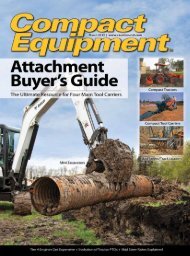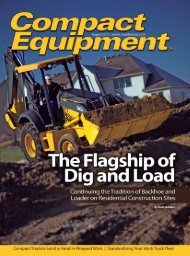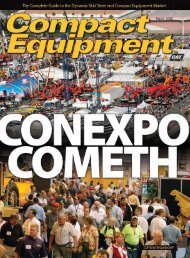CE EQUIPMENT CONNECTION - Compact Equipment
CE EQUIPMENT CONNECTION - Compact Equipment
CE EQUIPMENT CONNECTION - Compact Equipment
Create successful ePaper yourself
Turn your PDF publications into a flip-book with our unique Google optimized e-Paper software.
Every compressor salesperson claims to have the best<br />
product for the best price, but how can a contractor determine<br />
they’re getting the right compressor for the job? How does<br />
a contractor know what size compressor is needed? How<br />
powerful should the engine be? What should you expect of<br />
your dealer or rental house?<br />
According to Ted Flatt, director of strategic accounts for<br />
portable compressors at Ingersoll Rand, keep one thing in<br />
mind when choosing a compressor: What is the compressed<br />
air going to drive? Once you know the application, it’s<br />
just a matter of matching the intended use to a specifi c<br />
compressor size.<br />
Applications<br />
The majority of uses for compressed air in construction<br />
applications are for cleaning, blasting, renovation, installation<br />
or demolition.<br />
Abrasive Blasting<br />
Abrasive blasting applications use compressed air to remove<br />
scale, paint and rust from surfaces in order to prepare metal<br />
surfaces for painting, enameling and tinting. Compressors<br />
can also be used in conjunction with abrasive materials,<br />
such as sand and steel grit, to blast paint and residue off of<br />
bridges and water towers.<br />
Painting<br />
In painting applications, compressors are used to power<br />
painting tools and speed painting productivity on a variety<br />
of surfaces. For example, truck-mounted compressor models<br />
are often used for highway line painting.<br />
Utility<br />
Compressed air can be used in utility applications to operate air<br />
tools when repairing electric, water and sewer lines. Contractors<br />
can also use the air pressure for line testing to ensure there are no<br />
leaks and determine whether or not a line is able to hold certain<br />
levels of pressure. Compressors are also often used for powering<br />
directional drilling equipment laying fi ber-optic cable.<br />
Demolition<br />
Portable compressors are an ideal power source for pneumatic<br />
and hydraulic tools used to break concrete pavement,<br />
demolish concrete foundations and walls, as well as to cut<br />
pavement and sub-base.<br />
“Tools designed to be used with air compressors will have<br />
a pressure and volume rating listed on them,” says Flatt. “By<br />
knowing those two numbers, it’s just a matter of selecting<br />
the model that provides enough pressure and volume to run<br />
the tool. Basically, selecting a compressor requires matching<br />
the intended application to the pressure and volume of air<br />
necessary to complete the project.”<br />
32 <strong>Compact</strong> <strong>Equipment</strong> January 2008 compactequip.com








